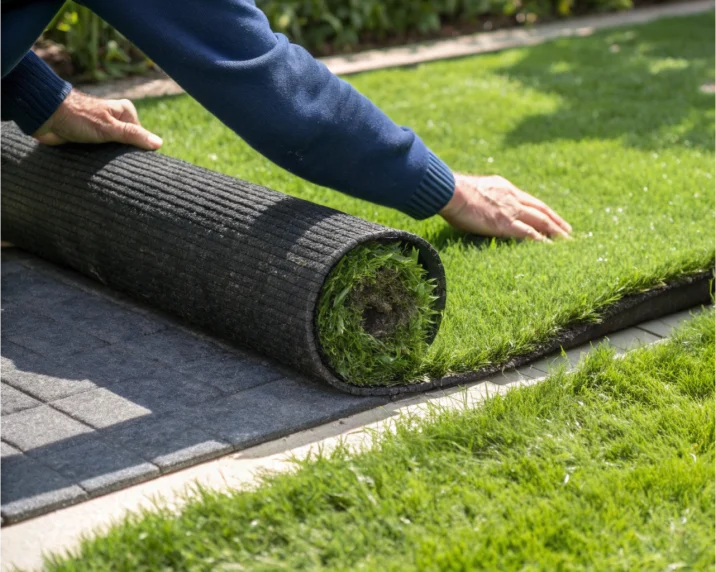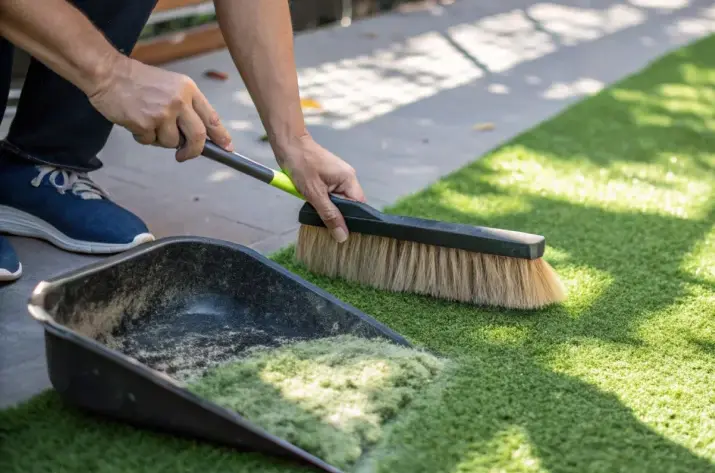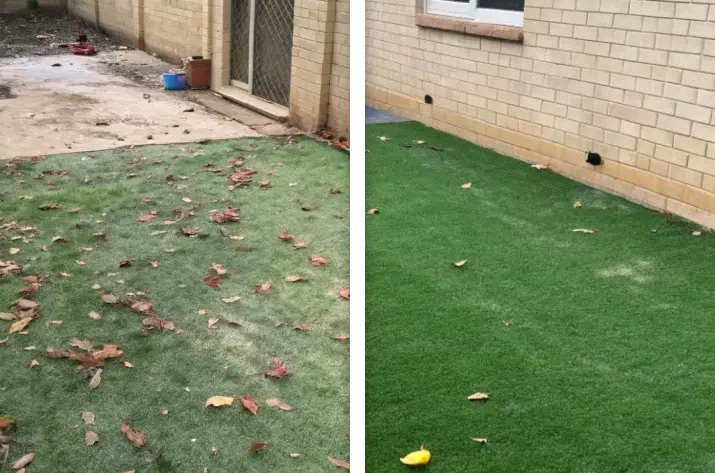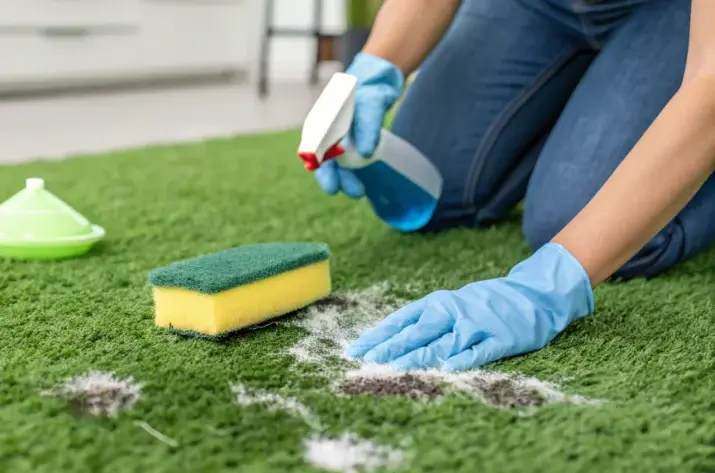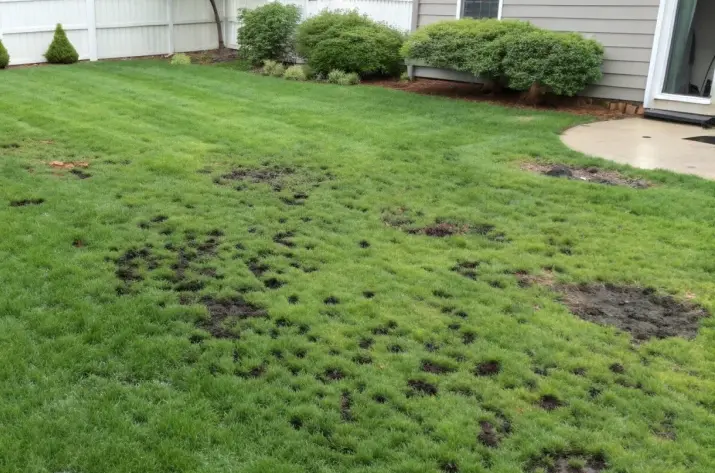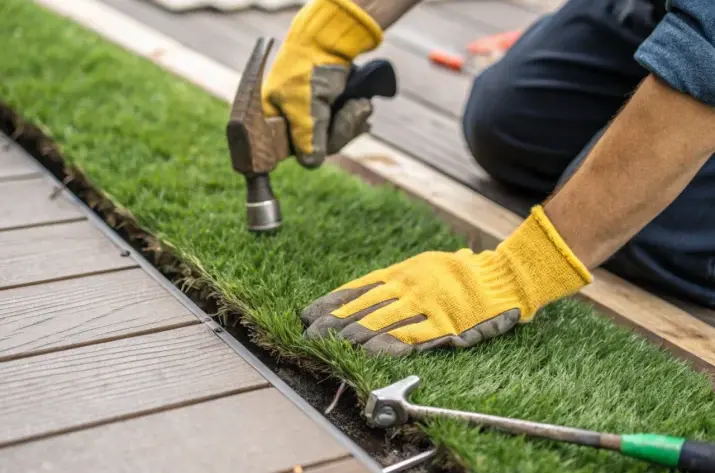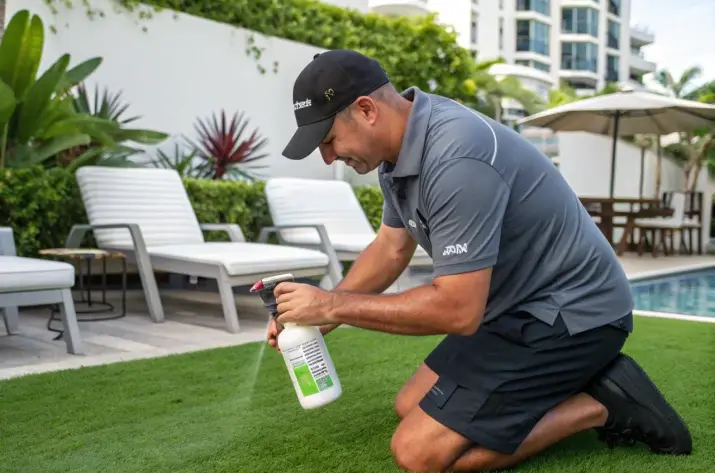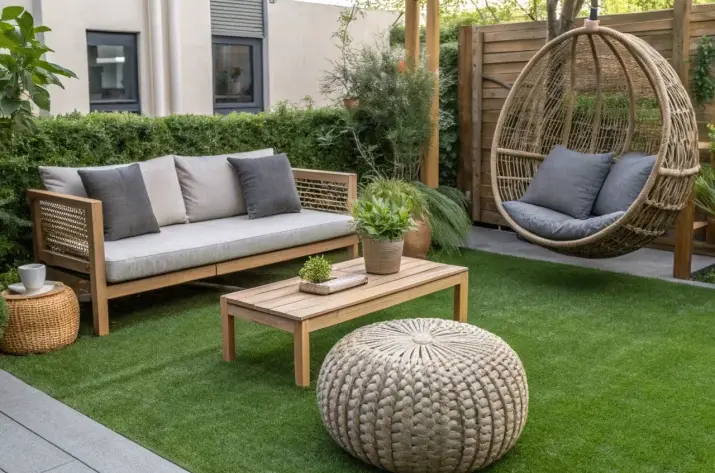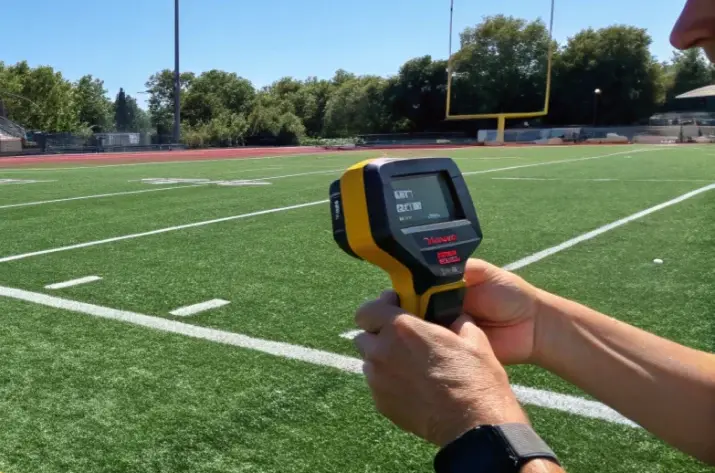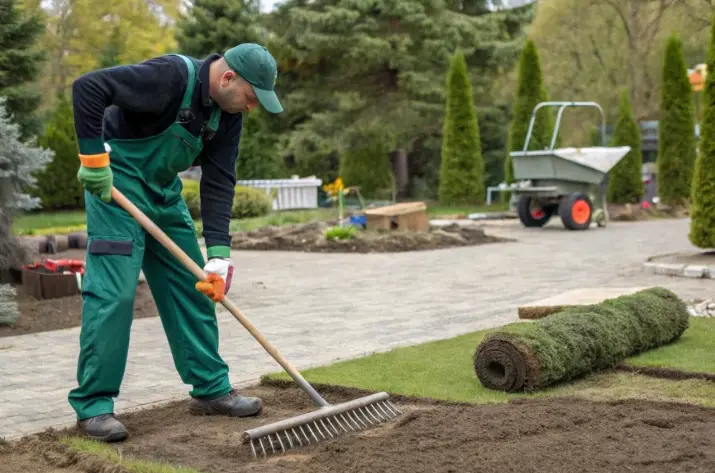Every backyard transforms into a haven when its grass stays vibrant under the sun, rain, or moonlight. Laying green turf turns that open patch into a stage for evening chats, playful pets, and weekend celebrations. In a face-off between natural and synthetic grass, the latter wins the battle as it holds the ground with an unchanging color.
It weathers heavy use of blazing sun and sudden storms while repaying its cost in time saved on mowing, watering, and repairs. Yet durability ranks as the biggest question in homeowners’ minds when they consider whether artificial grass is worth it or not.
The great news is that with simple routine care, you can extend your turf’s life. Keep reading for easy routines that lift blades back upright, freshen fibers, and keep your yard ready for every season’s moments.
High Quality Vs Low Quality Turf
When you’re weighing types of artificial grass, you’ll spot clear clues that set top performers apart from weak options:
High Quality Artificial Turf
- Fibers stand tall and rebound quickly after you press them down, so your lawn looks lush every day.
- Backing holds infill firmly in place and resists tearing even under heavy use.
- Drainage flows freely through the turf without puddles forming after rain or washing.
- Color stays rich and natural under sun exposure, resisting fading for many seasons.
- Artificial grass offers obvious advantages, such as low maintenance and a consistent appearance.
Low-Quality Artificial Turf
- Fibers collapse and stay flat when pressure hits them, leaving worn tracks in play areas.
- Backing cracks or peels away from the fibers after only a few months of use.
- Water sits on the surface in damp spots that breed odors and invite mold.
- Color looks artificial or dull and bleaches out quickly under UV rays.
- Promises lasting value but fails to deliver comfort and visual appeal.
What Happens When You Skip Turf Care
1. Turf Fibers Go Flat and Stay That Way
When you stop brushing the surface, you will notice the blades collapse under foot traffic and refuse to spring back. Those crushed areas trap dust and dirt particles, so the grass loses its lively bounce and looks sad and pressed down. Over time, the entire area develops permanent footprints that no amount of watering or rinsing can reverse. That loss of resilience not only makes your yard look tired but also shortens its usable life because compressed fibers break more easily.
2. Harmful Bacteria and Lingering Odors
Skipping a regular rinse for pet waste and spills lets organic residue seep into the backing material below the grass. Bacteria multiply in those hidden pockets and feed on leftover moisture. Soon, every step kicks up a faint but persistent odor that clings to shoes and pets’ fur. What began as a fresh-smelling space becomes a spot you avoid after rain or playtime because the musty smell never quite goes away.
3. Seams Loosen and Infill Clumps
Turf seams hide invisible stitches that hold two rolls of grass together. When you skip inspections, those stitches work themselves loose, and edges pull apart under use. Meanwhile, the infill material that gives the grass weight and support shifts into low points and corners. You start to see bald patches next to bulging ridges and rainwater pools in those dips. Overlooked for too long, those weak zones tear out under pressure and demand a costly section replacement instead of a simple seam repair.
4. Rapid Fading and UV Damage
Leftover dust, debris, and fallen leaves block airflow around the fibers so sunlight beats down unevenly on the same few strands. Those exposed blades bleach out first, leaving patchy streaks of pale color. Without brushing to lift debris, you get a spotted look that ages your investment in months rather than years. And that uneven fading cannot be reversed once the pigment has broken down under constant sun exposure.
5. Weed Intrusion and Root Problems
Skipping a quick lift of turf edges lets weed seeds slip into tiny gaps between the backing and soil. Over days, those seeds sprout and send roots upward, prying turf fibers aside. Tiny green shoots push through the surface until you find yourself yanking dandelions and crabgrass that claw at the backing. Each weed you pull leaves a wider gap for debris and water, and before long, those seams fray into ragged edges and worn patches as roots undermine your lawn’s foundation.
6. Slippery Surfaces and Safety Hazards
Leaving shaded or damp corners unchecked invites moss and algae to settle in and turn sturdy turf into a slick hazard. After rain or morning dew, play turns into an unexpected slip-and-slide that brings cautious tip-toeing instead of carefree fun. Children who once raced across the grass pause with every step, and guests edge along as if on an obstacle course. In no time, your backyard retreat feels less like a haven and more like a risky trek you’d rather avoid.
7. Pest Havens and Insect Infestations
When pet accidents or food spills go unwashed, you create invitations for ants, fleas, and even rodents to move in. Organic residues under the turf offer both shelter and a snack bar for insects, leading to tiny bites on bare feet and sudden scurrying underfoot. The more you skip cleaning, the larger the colony grows. This turns your low‑maintenance oasis into a mini wildlife refuge you never asked for.
8. Water Pooling and Mold Growth
Skipping routine brushing and infill top‑ups leaves fibers leaning in one direction, blocking the natural flow of rainwater. Puddles form in those concave dips, and stagnant moisture seeps into the backing. Within days, mold and mildew take root, blackening the grass strands and staining the base. Not only does that look unsightly, but it also poses a health risk for anyone rolling, sitting, or playing on the turf.
9. Warranty Voided and Costly Repairs
Nearly every artificial turf warranty demands proof of regular upkeep, from brushing logs to rinse records. When you skip tasks and let damage accumulate, manufacturers spot the mildew stains, patchy wear, and seam gaps, and then they’ll refuse to honor any replacement or repair claim. The result? You eat the full cost of fixing tears, reapplying infill, or buying an entirely new roll of turf. What began as a smart investment turns into a recurring expense because the paperwork no longer backs up your promise of care.
Benefits of Turf Maintenance
Many homeowners question how many years does artificial turf lasts? In most cases, standard turf stays vibrant for 10 to 15 years. With the right maintenance routine, turf installed by Elevated Seasons can hold its lush appearance for up to 25 years. We will explore the essential steps below to help you protect that investment and enjoy a brilliant, durable lawn for decades.
1. Greater Durability and Lifespan
Routine care keeps each blade standing tall and strong rather than flattening out. When fibers rebound properly after brushing, your surface weathers daily wear without thinning. That means you get the full benefits of artificial grass for many more seasons before it needs any replacement.
2. Consistent Cleanliness and Hygiene
A quick rinse after spills or pet visits stops grime from settling into the backing. You’ll spend less time battling stubborn stains or odors because debris never has a chance to cling. Clean turf not only looks inviting, but it feels safe for kids and pets.
3. Cost Savings Over Time
Skipping maintenance often leads to patch repairs or even full‑section replacement. A few minutes each month brushing and checking seams prevents costly fixes down the road. Over the life of your yard, you’ll see significant savings compared with reactive repairs.
4. Enhanced Safety and Comfort
Well‑groomed turf holds infill evenly so the surface stays soft underfoot and slip resistance stays high. That cushioning effect minimizes impact on joints during play and prevents unexpected trips when blades lie flat or infill shifts.
5. Aesthetic Appeal and Property Value
A consistently lush, vibrant lawn elevates your curb appeal and speaks to the quality of your entire property. Prospective buyers or guests notice a carpet of perfectly upright grass far more than a worn or patchy look. Proper upkeep translates directly into stronger perceived value.
6. Eco Friendly Edge
Regular sweeping of loose particles and low‑flow rinsing keeps water usage minimal. Since artificial turf never needs fertilizer or mowing, it already cuts chemical runoff and gas emissions. Maintenance simply preserves what makes your yard a greener choice in the first place.
Tips to Maintain Artificial Turf for Long-Term Durability
1. Weekly Fiber Fluff Sessions

Keeping fibers upright preserves softness. A quick weekly sweep revives appearance and spots early signs of wear.
- Pick a broom with firm plastic bristles rather than metal ones that can damage the backing.
- Brush against the grain of the fibers in three to four passes to lift blades evenly.
- Pay extra attention to pet and play areas where compression happens fastest.
- After brushing, walk across the turf to feel for any flat spots you may have missed.
- Finish with a gentle hose spray to settle any displaced infill and allow it to dry naturally.
- Jot down areas that need a second pass next week to track persistent pressure zones.
2. Immediate Debris Removal
Let leaves and pet waste linger, and drainage channels block up, creating damp spots where bacteria thrive. Clearing debris without delay prevents stains and odors and helps your artificial turf installation maintain peak performance.
- Scan the turf every two days for fallen leaves, twigs, or spills.
- Lift debris with a plastic leaf rake or a low-pressure blower to avoid shifting infill.
- Scoop pet waste into a sealed bag, then rinse the area with water and a touch of mild dish soap.
- Tackle sticky residues like sap by gently scrubbing with a soft brush before rinsing thoroughly.
- Blot leftover moisture with clean towels or allow the sun to dry damp patches.
- Trim back mulch and gravel beds at least six inches from the turf edge to reduce debris migration.
3. Quarterly Infill Top Up and Seam Check
Proper infill levels support blades, improve drainage, and stabilize seams after the turf setup. A seasonal review stops small gaps or dips from turning into costly repairs.
- Inspect all seam lines by pressing down lightly to feel for loose edges or separation.
- Walk the entire turf to find low spots where the infill feels thin or your foot sinks too deeply.
- Use the same infill material originally supplied, and mix ratios of sand and rubber affect performance.
- Distribute new infill evenly with a drop spreader or by hand, wearing gloves.
- Brush fibers after adding infill to work granules into the backing and restore pile height.
- Apply turf adhesive to any tiny seam gaps you notice to keep edges tight.
- Test drainage by hosing a one-foot square section and timing water clearance (ideally under thirty seconds).
- Record each inspection date, products used,
- and any issues spotted so you can track long-term trends.
4. Spot Sanitizing and Pet Stain Treatment
Act quickly on spills and pet accidents to preserve turf appearance and hygiene without harsh chemicals.
- Blot liquid messes with paper towels or an absorbent cloth immediately.
- Combine white vinegar and water in a 1 to 3 ratio in a spray bottle for natural disinfection.
- Spray affected areas and let the solution rest for five minutes before blotting again.
- Rinse thoroughly with clean water until all residue disappears.
- Gently scrub stubborn spots with a soft brush and rinse once more.
- Sprinkle baking soda over lingering odors, let it sit overnight, then vacuum it up.
5. Seasonal Algae and Moss Prevention
Damp shaded spots invite algae and moss that turn turf slick and unsightly. Seasonal treatments applied before growth takes hold preserve both safety and appearance.
- Inspect shaded corners after heavy rain for any slimy or green patches.
- Mix water with a turf-safe algicide following the manufacturer’s guidelines.
- Scrub treated areas with a stiff plastic broom to lift loosened growth.
- Rinse thoroughly with a hose to wash away dead moss or algae fragments.
- Trim overhanging branches to boost sunlight and discourage regrowth.
- Spread a thin layer of infill where fibers have thinned to improve drainage.
- Schedule this routine at the start and end of each wet season to stay ahead of outbreaks.
6. Annual Underlayment and Edging Inspection
Your turf’s foundation and perimeter keep the surface stable and neat. An annual check prevents unseen shifts that lead to gaps, tripping hazards, and water intrusion under the grass.
- Walk the perimeter looking for loose stakes or edging pieces that have been lifted.
- Check for any separation between turf backing and edging material.
- Press lightly along the underlayment to detect soft or sinking spots.
- Refasten edging stakes every few feet to secure the boundary.
- Fill small gaps under the turf edge with fine gravel or road base material.
- Roll a small section with a weighted roller to identify any uneven support.
- Document any major underlayment issues and plan for professional repair if needed.
7. Gentle Cleaning Solutions and Rinse Techniques
Use mild soap and clear water to clean turf fibers and prevent residue buildup that blocks drainage and invites mildew.
- Mix a few drops of pH-neutral dish soap into warm water in a bucket.
- Test the mixture on a small patch to confirm no discoloration.
- Scrub fibers with a soft-bristle brush in circular motions.
- Rinse with low-pressure spray until suds vanish.
- Repeat the process twice each year, especially after peak usage seasons.
- Press down on the turf to ensure water beads off without leaving a soap film.
8. Entryway Protection and Furniture Care
Place barrier mats and select wide-based furniture to distribute weight evenly and prevent compaction in high-traffic zones.
- Lay outdoor doormats at every entry to trap grit before it reaches the turf.
- Choose chairs with broad, flat legs or attach protective caps under chair legs.
- Move heavy planters periodically to avoid permanent wear spots.
- Position rubber-backed rugs where people tend to stand for long periods.
- Encourage barefoot traffic or soft-soled shoes to reduce surface abrasion.
- Inspect mats and rugs monthly and shake out trapped debris.
9. Monitoring Temperature Extremes and Stress Zones
Turf in direct sun can heat up more than natural grass. Tracking hot spots and shaded patches lets you take cooling or drying measures before damage sets in.
- After the first hot week of summer, walk the turf and note areas over 120°F (use an infrared thermometer if you have one).
- Water those sections lightly with a mist spray to bring temperatures down.
- In winter, check for frost or ice buildup that can stiffen fibers and backing.
- Relocate lightweight furniture off frozen patches until they thaw fully.
- Record any seasonal damage so you know where to focus next year.
- Consider installing shade sails where extreme sun exposure is constant.
10. Scheduled Professional Deep Maintenance
Even the best DIY care can miss hidden issues in the backing or infill. A certified turf specialist can perform a deep clean, power-rinse, and seam reinforcement to catch problems early.
- Book a professional service annually, preferably before peak use season.
- Request a power‑rinse to flush embedded dirt and fine particles from the backing.
- Ask for infill redistribution or replacement based on their inspection.
- Have them reseal or re‑adhere seams that show early signs of separation.
Conclusion
A thoughtful upkeep plan keeps turf fibers lively, drainage clear, and seams secure so your lawn remains a vibrant retreat year after year. You’ve seen how simple habits transform your investment into a stress-free, long-lasting surface that outperforms the normal ones.
The insights covered how to maintain artificial turf in depth, from fiber fluffing to seasonal checks that ward off stains, pests, and wear. When you’re ready for expert artificial turf installation in Los Angeles that stands strong for a long duration, Elevated Seasons is here to help. Contact us today to schedule your free consultation and take the first step toward a greener, more durable backyard.


